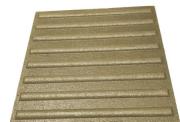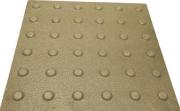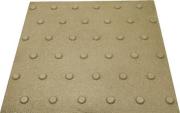
Tactiles 01787 377 322
Surface Mounted Tactile Paving for the Visually Impaired
Tactile GRP paving have distinctive, raised surface profiles designed to be detectable by visually impaired pedestrians. They are manufactured from hard wearing GRP and have an anti-slip grit finish. They are all 400mm x 400mm x 4mm thick at the lowest point. They can be easily fixed to an existing floor making the process quick and cost effective. All tiles have an anti-slip top surface allowing them to be installed both internally and externally. The tiles can be installed without the need to dig out to inset the tiles. There are 3 types of Tactiles available.
Corduroy Tactiles warns the visually impaired of hazards such as pedestrian crossings, level crossings, platforms or stairs. They consist of rows of half-round bars and indicate a hazard. Used at the top and bottom of stairs and on mid landings to clearly identify a change in elevation and to proceed with caution. Also used at intersections of shared cycle / pedestrian routes. They should be installed at 90 degrees and 400mm away from the hazard. Stone and Red available.
Blister off street Tactiles have evenly spaced rows of flat toped blisters parallel to the direction of travel. This indicates movement in this direction is safe. The blisters are even in one direction but offset in the other. The product is used as a hazard warning informing sighted and visually impaired persons they are approaching the edge of the railway platform and to proceed with caution. Platform edge paving should provide a good contrast in colour with the surrounding area to assist visually impaired persons.
– Install along the entire length of the platform
– Install parallel to the platform edge
– Position 600-700mm away from the platform edge
Platform edge paving should provide a good contrast in colour with the surrounding area to assist visually impaired persons.
Blister on-street Tactiles indicate the edge of a footway near a crossing. The blisters are even in both directions and serve as a safety feature where the footway is flush with the road. Blister Tactile Flag Paving is used to identify the location of a drop kerb and an appropriate place to cross. The blister surface is felt underfoot by the blind, and colours can be detected by the visually impaired. Red units are used at controlled crossing points and Stone colour units are used at uncontrolled crossing points.



